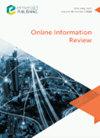Between remediating and participating: visuals of the Ford–Kavanaugh controversy on Instagram
IF 3.1
3区 管理学
Q2 COMPUTER SCIENCE, INFORMATION SYSTEMS
引用次数: 0
Abstract
PurposeThe study seeks to contribute to a deeper understanding of the relationship between remediations and participation in new media. By lending some transparency, the analysis hopes to contribute toward generating a critical optics aware of the potentials and pitfalls of emergent media.Design/methodology/approachThe methodology is visual semiotic analysis. The author make no claim for one, true interpretation or critical judgment about the images.FindingsIn demonstrating some shortfalls of Instagram affordances, the analysis shows how social media sites can develop tools that encourage users to engage in civic consciousness and respectful political debate. The study makes clear that new media tools can hamper or aid participatory logics.Originality/valueTo author’s knowledge, no other study that has analyzed remediated images related to the controversial confirmation of Brett Kavanaugh to the U.S. Supreme Court. It is also important to place these images in the contexts of “iconicity” in emergent media (a concept increasingly being eroded in new media environment).在补救和参与之间:Instagram上福特-卡瓦诺争议的视觉效果
目的本研究旨在加深对新媒体参与与补救之间关系的理解。通过提供一些透明度,该分析希望有助于产生一种意识到新兴媒体的潜力和陷阱的批判性光学。方法是视觉符号学分析。作者没有要求一个,真实的解释或对图像的批判性判断。除了展示Instagram的一些不足之处外,该分析还展示了社交媒体网站如何开发工具,鼓励用户参与公民意识和尊重政治辩论。这项研究清楚地表明,新媒体工具可以阻碍或帮助参与逻辑。原创性/价值据作者所知,没有其他研究分析过与布雷特·卡瓦诺(Brett Kavanaugh)向美国最高法院提出的有争议的确认有关的修复图像。同样重要的是,将这些图像置于新兴媒体的“象似性”背景中(这一概念在新媒体环境中日益受到侵蚀)。
本文章由计算机程序翻译,如有差异,请以英文原文为准。
求助全文
约1分钟内获得全文
求助全文
来源期刊

Online Information Review
工程技术-计算机:信息系统
CiteScore
6.90
自引率
16.10%
发文量
67
审稿时长
6 months
期刊介绍:
The journal provides a multi-disciplinary forum for scholars from a range of fields, including information studies/iSchools, data studies, internet studies, media and communication studies and information systems.
Publishes research on the social, political and ethical aspects of emergent digital information practices and platforms, and welcomes submissions that draw upon critical and socio-technical perspectives in order to address these developments.
Welcomes empirical, conceptual and methodological contributions on any topics relevant to the broad field of digital information and communication, however we are particularly interested in receiving submissions that address emerging issues around the below topics.
Coverage includes (but is not limited to):
•Online communities, social networking and social media, including online political communication; crowdsourcing; positive computing and wellbeing.
•The social drivers and implications of emerging data practices, including open data; big data; data journeys and flows; and research data management.
•Digital transformations including organisations’ use of information technologies (e.g. Internet of Things and digitisation of user experience) to improve economic and social welfare, health and wellbeing, and protect the environment.
•Developments in digital scholarship and the production and use of scholarly content.
•Online and digital research methods, including their ethical aspects.
 求助内容:
求助内容: 应助结果提醒方式:
应助结果提醒方式:


